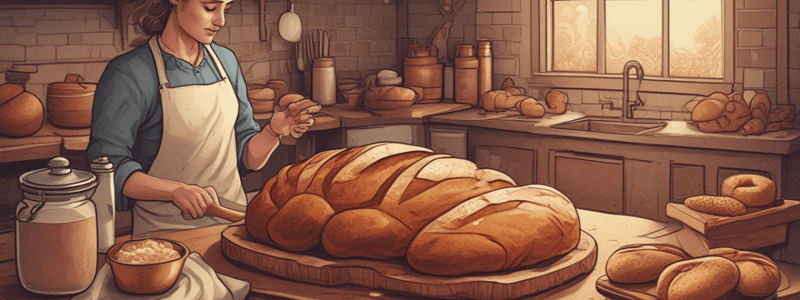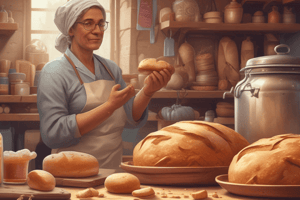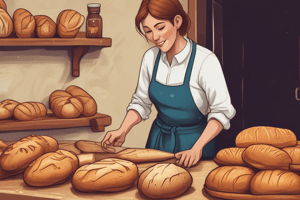Podcast
Questions and Answers
What is the primary benefit of using the autolyse technique in French bread production?
What is the primary benefit of using the autolyse technique in French bread production?
- Increasing the overall mixing time
- Incorporating salt and yeast at an earlier stage
- Minimizing the oxidation of carotenoids (correct)
- Eliminating the need for pre-ferments
What is the ideal duration of the autolyse rest period?
What is the ideal duration of the autolyse rest period?
- 2 hours to 4 hours
- 20 minutes to an hour (correct)
- 1 hour to 2 hours
- 10 minutes to 30 minutes
What is a characteristic of naturally leavened breads?
What is a characteristic of naturally leavened breads?
- High yeast content
- High salt content
- High sugar content
- High acidity (correct)
What is the consequence of using the autolyse technique on the gluten bonds in the dough?
What is the consequence of using the autolyse technique on the gluten bonds in the dough?
What is the primary function of protease during the autolyse phase?
What is the primary function of protease during the autolyse phase?
What type of sourdough breads is the autolyse technique not suitable for?
What type of sourdough breads is the autolyse technique not suitable for?
Why does the autolyse technique improve loaf volume in high-protein flours or sourdough breads?
Why does the autolyse technique improve loaf volume in high-protein flours or sourdough breads?
What is the result of using the autolyse technique on the overall mix time?
What is the result of using the autolyse technique on the overall mix time?
What is the benefit of the autolyse technique when making breads containing lots of whole-wheat flour?
What is the benefit of the autolyse technique when making breads containing lots of whole-wheat flour?
What is the characteristic of the crumb in bread made using the autolyse technique?
What is the characteristic of the crumb in bread made using the autolyse technique?
Why is salt not added to an autolyse?
Why is salt not added to an autolyse?
Who is credited with developing the autolyse technique?
Who is credited with developing the autolyse technique?
Why is yeast not added to an autolyse?
Why is yeast not added to an autolyse?
What is the translation of the French term 'autolyse'?
What is the translation of the French term 'autolyse'?
What is the exception to the rule of not adding pre-ferments to an autolyse?
What is the exception to the rule of not adding pre-ferments to an autolyse?
What is observed during the autolyse rest period?
What is observed during the autolyse rest period?
Flashcards are hidden until you start studying
Study Notes
Autolyse Technique
- Developed by Professor Raymond Calvel, a leading expert on French bread production
- Autolyse means "self-smoothing rest" period
- Beneficial for French bread production and naturally leavened sourdough breads (except rye-based)
Process of Autolyse
- Mix final dough flour and water at slow speed
- Do not include salt, yeast, or pre-ferments (except liquid levain or poolish)
- Cover and rest for 20 minutes to an hour
- Flour hydrates and gluten bonds develop during rest period
- Add remaining dough ingredients and mix on second speed
- Mixing time reduced by 40% or more
Benefits of Autolyse
- Reduces overall mixing time
- Minimizes oxidation of carotenoids
- Results in more aromatic loaves with a creamier, more open crumb and more pronounced cuts
- Can improve loaf volume, especially with high-protein flours or sourdough breads
- Allows easier dough expansion in the oven
- Favors better water absorption in whole-wheat flour doughs
Importance of Autolyse Rest Period
- Gluten bonds develop during rest period
- Flour enzyme protease breaks down protein bonds, improving loaf volume
- Bran absorbs more dough water, reducing cutting action on gluten strands
Exceptions and Considerations
- Salt, yeast, and pre-ferments are not added to autolyse to prevent tightening of gluten network or incipient acidity
- Liquid levain or poolish can be used as an exception
- High percentage of overall dough water in pre-ferment ensures sufficient hydration of flour
Studying That Suits You
Use AI to generate personalized quizzes and flashcards to suit your learning preferences.




